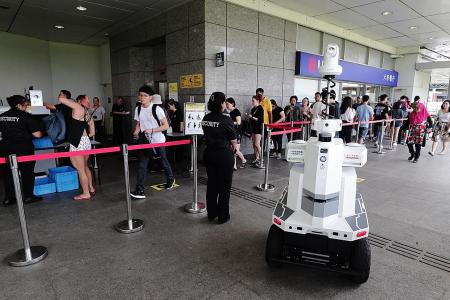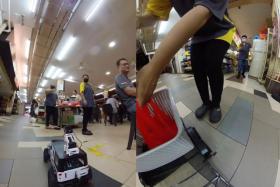Robots may soon guard MRT stations, bus interchanges
That watchful figure helping guard your MRT station or bus interchange may soon be a robot.
The Land Transport Authority (LTA) confirmed this after deploying one such robot at the Hougang MRT station yesterday to test its navigational and surveillance capabilities.
"The use of unmanned robots could potentially complement the deployment of security officers in the future," said the LTA.
Developed by ST Engineering, the 1.6m-tall robot was equipped with seven cameras to allow it a 360-degree view of its surroundings. It was equipped with an in-built global positioning system (GPS) as well as sensors such as lidar, which bounces lasers off objects, allow it to patrol designated areas.
INCIDENT MANAGEMENT
In future, it could even come with video and audio analytics technology, the LTA said.
"Through today's exercise, we will assess its potential to complement on-site surveillance needed for public transport incident management," said the LTA's public transport security deputy director Joseph Goh.
A similar robot was also deployed by the Singapore Police Force to patrol the Suntec Singapore International Convention and Exhibition Centre during the 33rd Asean Summit last month.
The control console for the LTA's robot was located within a nearby incident response vehicle that was equipped with telecommunications equipment and a camera system.
This can transmit live footage to a the LTA's Land Transport Operations Centre at its Hampshire Road headquarters.
Yesterday, the robot did duty at an emergency preparedness exercise dubbed Exercise Station Guard, where commuters had to go through metal detectors and pass their belongings through X-ray scanners.
It was the third such operation by the LTA this year.
Earlier exercises were conducted at the Newton station in February, and the Holland Village station in July.
Transport nodes remain "attractive" targets to terrorists, said Dr Rohan Gunaratna, who heads the International Centre for Political Violence and Terrorism Research at the S. Rajaratnam School of International Studies.
"What is essential is not only to train security personnel but non-security staff serving MRT stations to detect suspicious activity. Working with commuters to raise public awareness is paramount," he said.
Get The New Paper on your phone with the free TNP app. Download from the Apple App Store or Google Play Store now



